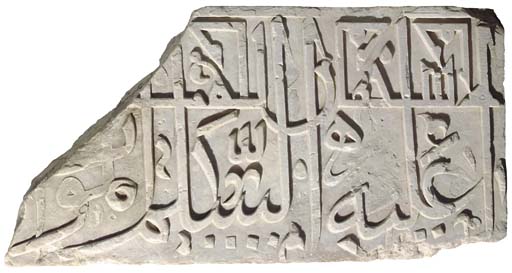

An inscription panel in thuluth and kufic, Samarqand, 1404
Source: http://www.christies.com/LotFinder/search/LOTDETAIL.ASP?sid=&intObjectID=4272297&SE=CMWCAT03+569227+%2D892283453+&QR=M+1+0+Aqc0000900+540931++Aqc0000900+&entry=india&SU=1&RQ=True&AN=1
(downloaded Apr. 2004)
A CARVED WHITE MARBLE INSCRIPTION PANEL FROM THE GUR-I MIR, SAMARKAND, 1404 AD. Of rectangular form carved in high relief with a very strong thuluth inscription overlaid above by a kufic band, occasional leafy forms around the inscription, a plain border stripe above, broken at one side, various damages. 17 5/8 x 34½in. (44.7 x 87.6cm.).
Provenance Purchased by the father of the present owner from the family of a Central Asian architect who had worked under the art historian I.I. Umniakov on the restoration of the Gur-i Mir in the 1920s.
Lot Notes: The inscriptions are:
In cursive, parts of a salutation: "Upon him [be] peace"
In Kufic : "Praise be to God"
Timur began the construction of his mausoleum in 1404 on the site of the madrassa and khanagah (monastery) of his grandson Muhammad Sultan. Timur was later buried there and his tomb is marked by a dark green jade cenotaph of striking beauty. The Gur-i Mir is one of the most imposing buildings in Samarkand; the woodwork, stone carving and tilework is of the highest quality. The cutting of marble and engraving of inscriptions for the building of a mosque in Samarkand is shown in a miniature of the Zafarnama of circa 1480 in the Walters Art Gallery, T.L.6 1950 (360a).
The Umniakov expedition worked in Samarkand from 1920-1928. They were involved in the conservation and restoration of several Islamic monuments in Russian Turkestan, principally working on the Gur-i Mir. The marble panels with hadith inscriptions such as the present piece, encircled the interior walls of the mausoleum. Today up to a quarter of the panels are replacements.
Lawton, J.: Samarkand and Bukhara, London, 1991, p.66
Lentz, T.W. and Lowry, G.D.: Timur and the Princely Vision, LACMA,
1989, pp.28, 34, 36.
Titley, N.: Persian miniature painting, London, 1983, fig.34, p.73
Unmiakov, I.I.: Arhitekturnye Pamiatniki Srednei Azii (The Architectural Monuments
of Central Asia), Tashkent, 1929."